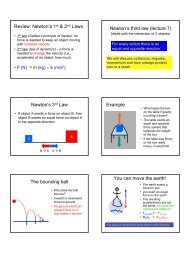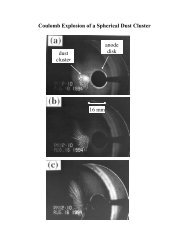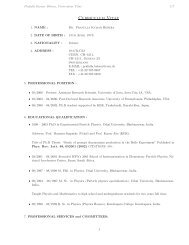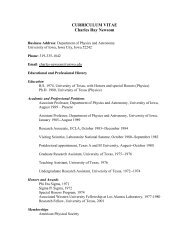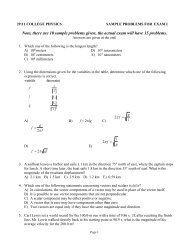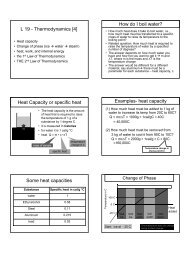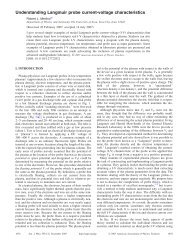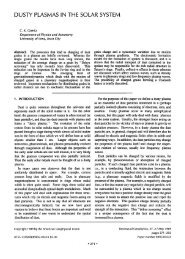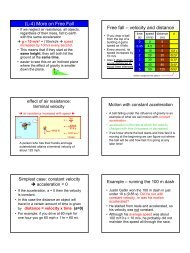Radiation-Hard Quartz Cerenkov Calorimeters - The University of Iowa
Radiation-Hard Quartz Cerenkov Calorimeters - The University of Iowa
Radiation-Hard Quartz Cerenkov Calorimeters - The University of Iowa
Create successful ePaper yourself
Turn your PDF publications into a flip-book with our unique Google optimized e-Paper software.
<strong>Radiation</strong>-<strong>Hard</strong> <strong>Quartz</strong> <strong>Cerenkov</strong><strong>Calorimeters</strong>Yasar Onel<strong>The</strong> <strong>University</strong> <strong>of</strong> <strong>Iowa</strong>(on behalf <strong>of</strong> CMS Collaboration)THE UNIVERSITY OF IOWAY. Onel, CALOR2006, Chicago1
Outline• Introduction to <strong>Quartz</strong> Calorimetry• <strong>Quartz</strong> as radiation hard material• <strong>Quartz</strong> <strong>Calorimeters</strong> for the CMS Detector– <strong>Quartz</strong> Fiber <strong>Calorimeters</strong>• PPP1 -- Prototype•HF– <strong>Quartz</strong> Plate <strong>Calorimeters</strong>•Castor• QPCal Prototype• ConclusionTHE UNIVERSITY OF IOWAY. Onel, CALOR2006, Chicago2
Introduction• <strong>The</strong> detector is intrinsically radiation hard at the required level(hundreds <strong>of</strong> MRads)• <strong>The</strong> detector, for all practical purposes, is sensitive to theelectromagnetic shower components (ρ M)• It is based on Cherenkov radiation and is extremely fast (< 10 ns)• Low but sufficient light yield ( 1 / nTHE UNIVERSITY OF IOWAY. Onel, CALOR2006, Chicago3
<strong>Quartz</strong> <strong>Radiation</strong> Damage• Scientific literature about optical characteristics <strong>of</strong> <strong>Quartz</strong> fibers is generally in the infrared band (800nm,1300nm, 1550nm studied a lot…)• Many <strong>of</strong> these studies conducted by γ or e - irradiation• Our studies concentrated on 325-800 nm range– PMT sensitivity 400-500 nm• Three experiments were carried out– UTR-10 , 10 kWatt Reactor @ ISU, Ames• Total γ dose ~ 22 kRad• Neutron Flux: 1.3x1010 n/cm2/s/kW• Integrated neutron fluence at the end <strong>of</strong> experiment: ~1x1015 n/cm 2– MGC-20E cyclotron <strong>of</strong> ATOMKI in Hungary• 18 MeV proton incident on 3 mm thick Be-target to generate neutrons, =3.7 MeV• Eneutron ranged up to 20 MeV• 25.3 hours <strong>of</strong> operation, total neutron fluence ∼1.02 x 1015 n/cm2 ±18%• Average nfluence at the cylinder ∼ 0.6 x 1015 n/cm2• During Irradiation, the dose rate was constant ∼ 1.1 x 1010 n/cm2/sec ±18%– <strong>The</strong> Intense Pulsed Neutron Source (IPNS) at Argonne National Laboratory• IPNS produces neutrons by Uranium fission induced by a proton beam• <strong>The</strong> fission reaction also produces gamma radiation• 15 uA <strong>of</strong> 450 MeV protons over 313 hours (2 weeks) produced 7.42 x 10 17 n/cm 2• Average fiber dose was calculated as 17.6 Mrad neutron and 91.1 Mrad gammaTHE UNIVERSITY OF IOWAY. Onel, CALOR2006, Chicago4
<strong>Quartz</strong> <strong>Radiation</strong> DamageAttenuationA(λ, D) = - (10/L)log 10 [I(λ, D)/I(λ,0)]• Obtained using previoustwo spectrum.• <strong>The</strong>re is no transmissionbelow 350 nm.• Relatively biggerattenuation at 610 nm.• No effect between 700and 800 nm in ourmeasurement precision.• Relative deep around450 nm.54 MRadTHE UNIVERSITY OF IOWAY. Onel, CALOR2006, Chicago7
<strong>Quartz</strong> <strong>Radiation</strong> Damage• Seven sets <strong>of</strong> quartz in the form <strong>of</strong> fiber are irradiated inArgonne IPNS for 313 hours.• <strong>The</strong> fibers were tested for optical degradation before and after17.6 Mrad <strong>of</strong> neutron and 73.5 Mrad <strong>of</strong> gamma radiation.• Polymicro manufactured a special radiation hard solarizationquartz plate.• Seven types <strong>of</strong> quartz fibers were cleaved• <strong>The</strong> fibers were loaded into an Ocean Optics SD2000 digitalspectrometer• CMS IN-2006/014THE UNIVERSITY OF IOWAY. Onel, CALOR2006, Chicago8
CMS DetectorBarrel Hadron (HB) CalorimeterForward Hadron (HF) CalorimeterEndcap Hadron (He) CalorimeterTHE UNIVERSITY OF IOWAY. Onel, CALOR2006, Chicago9
PPP - IReadOut BoxDAQSide ViewLIGHTGUIDELIGHTGUIDELIGHTGUIDELIGHTGUIDELIGHTGUIDEPMTPMTPMTPMTPMT1 0PPP - I (PreProduction Prototype)Schematic ViewBeam<strong>Quartz</strong> FibersSteel Absorber165cmEM Fiber143cm30cmHAD FiberTC Fiber<strong>The</strong> pattern used toembed the fibersin the iron matrixLateral cross section7 8 918cm4 5 61 2 318cm<strong>The</strong> PrototypeTHE UNIVERSITY OF IOWAY. Onel, CALOR2006, Chicago10
PPP - IROBox( Light Guides)R6425 PMTsFiber Bundles(EM, HAD and TC)300-micron core QPLED, Laserand PIN PDsIronAbsorber(9.5 λ I )FerrulesRadioactiveSourceTubes3 x 3 Towerstructure(6 cm x 6 cm)THE UNIVERSITY OF IOWAY. Onel, CALOR2006, Chicago11
PPP - IPrevious Experimental Data on Photodetectors by HF GroupHamamatsu R6427 at 350GeV Pion BeamTHE UNIVERSITY OF IOWAY. Onel, CALOR2006, Chicago12
PPP - ISpatial uniformity with electron and pion beamsA.S.Ayan, Ph.D. <strong>The</strong>sis, 2004THE UNIVERSITY OF IOWAY. Onel, CALOR2006, Chicago13
PPP - IDetector Response to 100 GeV electron and 225 GeV pionTHE UNIVERSITY OF IOWAY. Onel, CALOR2006, Chicago14
PPP - IEnergy Response Linearity• HF PPP1 responds linearly within 1% to electrons in the energy range tested (6 -200 GeV). <strong>The</strong> π - response is highly nonlinear.J. Phys. G: Nucl. . Part. Phys. 30 N33-N44, N44, (2004)THE UNIVERSITY OF IOWAY. Onel, CALOR2006, Chicago15
PPP - IEnergy Resolution(σ/E) 2 = (a/√E) 2 + b 2a = 197 % b = 8%THE UNIVERSITY OF IOWAY. Onel, CALOR2006, Chicago16
CMS Forward DetectorsTHE UNIVERSITY OF IOWAY. Onel, CALOR2006, Chicago17
HF CalorimeterTHE UNIVERSITY OF IOWAY. Onel, CALOR2006, Chicago18
HF CalorimeterHAD (143 cm)5mm• To cope with high radiation levels (>1 Gradaccumulated in 10 years) the active part is<strong>Quartz</strong> fibers: the energy measured through the<strong>Cerenkov</strong> light generated by shower particles.EM (165 cm)• Iron calorimeter, composed <strong>of</strong> 20 0 wedges• Covers 5 > |η| > 3• Total <strong>of</strong> 1728 towers• 2 x 432 towers for EM and HAD• η x φ segmentation (0.175 x 0.175)THE UNIVERSITY OF IOWAY. Onel, CALOR2006, Chicago19
HF Calorimeter• HF are first Items to be lowered in July 2006• Fibers inserted in all 36 wedgesLight GuideTHE UNIVERSITY OF IOWAY. Onel, CALOR2006, Chicago20
HF CalorimeterHF in 186 ServicesTHE UNIVERSITY OF IOWAY. Onel, CALOR2006, Chicago21
HF CalorimeterHF Test Beam Results• <strong>The</strong> beam line at the CERN H2 beam line for the HF calorimeter tests.• A single HF wedge, mounted on a table that could be moved remotely• horizontal and Vertical directions• tilted in the vertical plane up to 6 degrees with respect to the beam direction.• <strong>The</strong> electromagnetic energy resolution is dominated by photoelectron statistics.• a = 198%, b = 9%• <strong>The</strong> hadronic energy resolution is largely determined by the fluctuations in the neutral pionproduction in showers, a = 280% and b = 11%.CMS NOTE 2006/044THE UNIVERSITY OF IOWAY. Onel, CALOR2006, Chicago22
HF CalorimeterTest Beam Verification via Geant4 SimulationT.Yetkin, , Ph.D. <strong>The</strong>sis, 2006Beam Sim. Geometry Sim. Physics Sim. AnalysisSpatially distributed(randomly to generate square,circle, spherical, etc.) orpoint-like beam spot. In HFbeam spot is square shape.pName,P,EBuild geometry as close aspossible to the real geometrywith same materials. In HFsimulation passive material isiron and active material isquartz...Electromagnetic andHadronic Physics Simulationwith the interface <strong>of</strong> PhysicsLists (matter-particleinteractions and showering).Cherenkov process is addedexternally for the energy loss<strong>of</strong> charged particles insidequartz fibers.ShowerconstructionNumber <strong>of</strong> photo-electronsare stored at the end <strong>of</strong>simulation. Towers areread out separately. ROOTis the package for analysisframework.~Gun Position....n 2n 1~<strong>Cerenkov</strong> ProcessHistogramsTHE UNIVERSITY OF IOWAY. Onel, CALOR2006, Chicago23
HF Calorimeter• Active material is quartz fiber (~600µm diameter). Two set <strong>of</strong> fibers are embedded to thepassive material which is steel: Long (165 cm) and Short (143 cm) fibers.Figures fromGeant4SimulationTHE UNIVERSITY OF IOWAY. Onel, CALOR2006, Chicago24
ElectronHF CalorimeterResponse <strong>of</strong> HF detector (L+S)Pion30 GeV150 GeVTHE UNIVERSITY OF IOWAY. Onel, CALOR2006, Chicago25
HF CalorimeterEnergy Resolution (L+S)ElectronPionTHE UNIVERSITY OF IOWAY. Onel, CALOR2006, Chicago26
HF CalorimeterResponse Linearity• Linearity is the measure <strong>of</strong> detector response and it is defined as the ratio <strong>of</strong> measuredenergy to incoming beam.LongShort• HF response is constantwhen electrons aremeasured with the longfibers only. However withthe increased energy theshort fibers start to registerenergy and it becomes nonlinear.For pions the nonlinearityis seen in bothcases. <strong>The</strong> simulationresults are agree with thetest beam data.ElectronPionTHE UNIVERSITY OF IOWAY. Onel, CALOR2006, Chicago27
HF Calorimeterpion/electron Ratio• Taking the short fiber into account makes HF pi/e ratio independentfrom energy.THE UNIVERSITY OF IOWAY. Onel, CALOR2006, Chicago28
CASTOR Calorimeter• Each set <strong>of</strong> tungsten and quartz plates covers 45 0 in azimuth. <strong>The</strong>re are two 22.5 0 quartz plates foreach tungsten plate. <strong>The</strong> light from 7 quartz plates collected by a light guide and directed to a PMT.THE UNIVERSITY OF IOWAY. Onel, CALOR2006, Chicago29
CASTOR CalorimeterPrototype and Test Resultshttp://cms.doc.cern.ch/castor/THE UNIVERSITY OF IOWAY. Onel, CALOR2006, Chicago30
CASTOR Calorimeter(5.32 < η < 6.71)ZDC(z = ± 140 m)(5.32 < η < 6.86)• Near Hermetic coverage (out to |η|
HE Upgrade for SLHC• <strong>The</strong> Super LHC scenarios requires a detector upgrade on CMS HECalorimeter. Due to the radiation damage problem on the scintillators.• <strong>Quartz</strong> plates are proposed as a substitute for the scintillators at the HadronicEndcap (HE) calorimeter.• With the quartz the light is from <strong>Cerenkov</strong> radiation. <strong>The</strong> number <strong>of</strong>Cherenkov photons created in quartz is ~1-2% <strong>of</strong> the scintillation photons in aregular HE plate.• We have been performing some R&D studies to develop a highly efficientmethod for collecting <strong>Cerenkov</strong> light in quartz with wavelength shifting fibers.• We are also constructing a prototype calorimeter, fist 6 layers have been testedat Fermilab test beam. This summer we’ll take whole prototype to Cern testbeam.THE UNIVERSITY OF IOWAY. Onel, CALOR2006, Chicago32
HE Upgrade for SLHCCollecting <strong>Cerenkov</strong> Light in <strong>Quartz</strong> Plates• We have tested/simulated different fiber geometries in the quartz plates, for their lightcollection uniformity and efficiency.THE UNIVERSITY OF IOWAY. Onel, CALOR2006, Chicago33
HE Upgrade for SLHCTest Beam Results and Simuations• WaveLength Shifting (WLS) fiber, Bicron 91a, isembedded in the quartz plate. <strong>Quartz</strong> plates are wrappedwith reflecting material <strong>of</strong> 95 % efficiency.• <strong>The</strong> <strong>Cerenkov</strong> photons reaching the PhotoMultiplierTube(PMT) are counted.• <strong>Cerenkov</strong> Photons are shown in green. Photons emitted byWLS process are shown in red.• At the test beams we compared the light collectionefficiencies with that <strong>of</strong> original HE scintillators.THE UNIVERSITY OF IOWAY. Onel, CALOR2006, Chicago34
HE Upgrade for SLHCSurface Uniformity Tests and Simulations• We simulated the collected light with 4 GeV electron beam and counted the number <strong>of</strong> wavelengthshifted photons reaching the PMT.• We also performed bench tests on the light collection uniformity with different light sources.THE UNIVERSITY OF IOWAY. Onel, CALOR2006, Chicago35
HE Upgrade for SLHC<strong>The</strong> Final Fiber Geometry• We used the “chosen” geometry on the prototype.• <strong>The</strong> signal is read by Hamamatsu R7525 PMTs• <strong>The</strong> fibers are 1mm diameter Bicron wavelengthshifting fibers. <strong>The</strong>y absorb photons down to 280 nm,emit 435 nm.• <strong>The</strong> fibers go ~20 cm out <strong>of</strong> the quartz.THE UNIVERSITY OF IOWAY. Onel, CALOR2006, Chicago36
HE Upgrade for SLHC<strong>The</strong> Calorimeter Prototype Design and Simulations• R&D results and initial model shaped the prototype.• <strong>The</strong> final design:– 20cm x 20cm, 20 layers 70 mm iron, 5 mm quartz– Should be portable for tests at CERN, Fermilab, and <strong>Iowa</strong>– <strong>The</strong> <strong>Cerenkov</strong> light is collected by wavelenght shfting fibers and carried to theHamamatsu R7525 PMT.THE UNIVERSITY OF IOWAY. Onel, CALOR2006, Chicago37
HE Upgrade for SLHCPrototype Test Beam at Fermilab M-Test• On Feb. 2006 we tested first 6 layers <strong>of</strong> the calorimeter at FermilabM-Test.• <strong>The</strong> preliminary results are encouraging, we collect cerenkovphotons as many as 75% <strong>of</strong> the scintillation photons.• We’ll have beam time at Cern this summer for the wholecalorimeter.THE UNIVERSITY OF IOWAY. Onel, CALOR2006, Chicago38
<strong>Cerenkov</strong> CompensationPrecision Calorimetry• Basic Idea:<strong>Cerenkov</strong> Light is most sensitive to electrons (photons)Ionization sensitive to neutrons, hadrons, electronsUse these 2 measurements to correct calorimeter energy – stochastic & constant terms• Detect both <strong>Cerenkov</strong> Signal Ec and Ionization Ei on the same shower.• For pure e-m showers, normalize the detected energies so that Ei = Ec = Eem.• For hadrons, only when only p 0 are produced does Eh ~ Ei ~ Ec.• As Eh fluctuates more into n, p +- , etc., Ec decreases faster than Ei.• On an Ec vs Ei scatter plot, the fluctuation is correlated/described by a straight line with slope a
Conclusion• We have developed the technology for radiation hardcalorimeters using quartz fibers and quartz plates.• Studied in detail the radiation hardness <strong>of</strong> quartz corematerial with proton, neutron, gamma, and electronbeams.• Built the CMS-PPP-I, CMS-HF, and also working on theCMS-ZDC, CMS-CASTOR, and CMS-HE upgradedetectors.• We have simulated the above detectors with Geant4 andcompared the results with the test beams.THE UNIVERSITY OF IOWAY. Onel, CALOR2006, Chicago40
Backup SlidesTHE UNIVERSITY OF IOWAY. Onel, CALOR2006, Chicago41
Low-x measurements with HFTHE UNIVERSITY OF IOWAY. Onel, CALOR2006, Chicago42
CMS CoverageTHE UNIVERSITY OF IOWAY. Onel, CALOR2006, Chicago43



